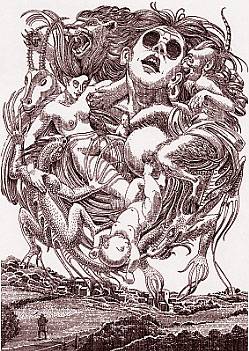
![]() Changing Planes by Ursula K. Le Guin
Changing Planes by Ursula K. Le Guin
Airports are horrible places — the boring waits, the noisy rush, the germy stale air, the ugly utilitarian décor, the nasty food. That is, until Sita Dulip, while waiting for her delayed flight from Chicago to Denver and noticing that “the airport offers nothing to any human being except access to the interval between planes,” developed a technique to change planes inside the airport. She discovered that in the airport the traveler is uncomfortable, displaced, and already between planes and can therefore easily slip into other planes of existence while waiting for a flight.
Sita Dulip’s technique has now been publicized and travelers everywhere are using it to alleviate airport boredom. Changing Planes is a collection of fifteen of their stories. A few of the stories are mainly anthropological or linguistic explorations of imaginary cultures, but readers who are familiar with Ursula Le Guin won’t be surprised to learn that many of the stories make some sort of satirical statement about human behavior, and especially American culture. Even the short introduction manages to take a swipe at conservative politicians, authors who write bestsellers and, of course, corporations that run airlines.
Le Guin’s method of using several different worlds to highlight the problems (or potential future problems) in our own, and the social satire, make Changing Planes feel somewhat like Jonathan Swift’s Gulliver’s Travels, which I enjoyed many years ago. Almost all of the stories in Changing Planes are poignant, and some of them will stick with me for a long time. Those I liked most are:
- “Porridge on Islac” — In an attempt to genetically engineer better species of humans, animals, and plants, the Islacs are now left with a very strange society. The cover art for the first edition comes from this story.
- “The Silence of the Asonu” — Adults on Asonu don’t say much, so people from other planes think they are hiding a sacred secret. They desperately want to find out what it is.
- “Feeling at Home with the Hennebet” — The people of Hennebet have strange but charming ideas about self-identity and time perception.
- “Social Dreaming of the Frin” — In Frin, dreams are not private. Each night, the Frins dream communally.
- “The Royals of Hegn” — In Hegn, everyone has descended from royalty, except for one family. This funny social satire pokes fun at our love of celebrities.
- “Woeful Tales from Mahigul” — The four very short tales in this mini-collection were read by a traveler sitting in the beautiful outdoor library of Mahigul. I wish I could go there!
- “Wake Island” — Genetic engineering again. This frightening story is about a cohort of youngsters who were engineered to need no sleep. Scientists hoped they’d be geniuses, but it didn’t turn out quite like that.
- “The Island of the Immortals” — On this plane, diamonds are not valuable and immortality is a disease.
 Each of these stories is, of course, written in Le Guin’s straightforward, unpretentious, smart and lovely style. The audiobook version is narrated by Gabrielle de Cuir, whose attractive voice perfectly fits this style. Whenever I review an audiobook, I like to pick up a print copy from my library, too, just so I can see if I’m missing anything. Sure enough, if I hadn’t looked at the print version, I would have missed the delightful black and white illustrations by Eric Beddows. I especially liked the picture of the communal dream in “Social Dreaming of the Frin.”
Each of these stories is, of course, written in Le Guin’s straightforward, unpretentious, smart and lovely style. The audiobook version is narrated by Gabrielle de Cuir, whose attractive voice perfectly fits this style. Whenever I review an audiobook, I like to pick up a print copy from my library, too, just so I can see if I’m missing anything. Sure enough, if I hadn’t looked at the print version, I would have missed the delightful black and white illustrations by Eric Beddows. I especially liked the picture of the communal dream in “Social Dreaming of the Frin.”
Changing Planes won the 2004 Locus Award for best story collection. Many of the stories had been previously published over several years before being combined to form this themed collection, but they work beautifully together. All of them are short escapes into fascinating new planes of existence. Changing Planes would be the perfect book to read next time you’re waiting for a flight!



I think the concept behind this is really clever! :) I may have to try it.